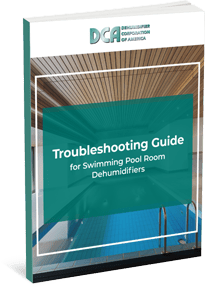Any commercial or industrial setting involving the general public—or any other situation involving excessive humidity—is a prime candidate for dehumidification. The two common types of dehumidifiers available for these applications are either mechanical or desiccant dehumidification systems. These two types vary considerably and actually do not compete; rather, each has a definite place depending on what dew point is needed. General mechanical dehumidification is effective above 60% dew point applications. Dew point requirements below 60% are best served with desiccant systems.
Dehumidifier Corporation of America (DCA) provides high-quality mechanical dehumidification systems to meet a variety of industrial and commercial humidity control needs. Learn more about how dehumidification works and the common applications for dehumidification systems.
What Is Dehumidification?
During the dehumidification process, water vapor or moisture is removed from the air as it passes through the dehumidifier. Each pass through the dehumidifier removes a certain amount of moisture and returns to the room either warm or cool dry air depending on the dehumidifier options specified. On a psychrometric chart, this process would be shown by a vertical line between the initial value to the final value of relative humidity.
With mechanical dehumidification systems, the leaving air temperature is warmer than the entering air temperature because through the dehumidification cycle both the latent and sensible heat gain account for this gain. Mechanical systems also can be optioned with remote condensers that allow the system to deliver cool dry air or warm dry air depending on what the controls are calling for. If additional room heating is needed for some reason, an add-on electric or gas duct heater can be specified. Hot water coils can also be added in the unit if additional room heating is needed.
The Dehumidification Process
Mechanical dehumidifiers contain both an evaporator coil (cold coil) and a condenser coil (warm coil). As the moist room air passes over the cold coil, the air temperature is lowered to its dew point, and the water vapor is condensed out of the air and collected in a drain pan. The air leaving the cold coil immediately enters the warm coil, where that air is warmed approximately 10 degrees over the air entering the dehumidifier, depending on the moisture load on the cold coil at that time. When cool dry air is called for, an optional outdoor remote condenser is added to the dehumidifier, and the unwanted warm air is rejected outdoors.
Another useful feature is optional pool water heating. When the dehumidifier is equipped with an optional pool water heating coil, the otherwise wasted heat generated by the dehumidifier is transferred to adding heat to the pool water. All of these functions are controlled automatically with the dehumidifier control system.
Sectors That Benefit From Industrial Dehumidifiers
DCA industrial/commercial dehumidification systems are built to handle high-volume or high-frequency dehumidification functions. They are frequently used in the following locations:
- Indoor swimming pool rooms: Water constantly evaporates from pools, making the air inside indoor pool rooms moisture-laden. For this reason, pool rooms require near-constant dehumidification to mitigate condensation, mold growth, corrosion, and building decay risks. DCA’s pool room dehumidifiers normally discharge warm dry air back to the pool room. When cool or warm dry air is needed, the dehumidifier can be equipped with an optional outdoor remote condenser, allowing the system to furnish either warm or cool dry air depending upon what the room controls are asking for.
- Industrial warehouses: Storage facilities for consumer and commercial goods—such as perishable goods, construction materials, fabrics, and furniture—rely on dehumidifiers to provide complete climate control. Warehouses in hot and humid climates, especially, need reliable, effective humidity control through dehumidification.
- Gymnasiums: Climate control and dehumidification play a large role in keeping fitness areas comfortable and clean.
- Schools: Schools and school gyms also need dehumidifiers to protect and mitigate risks of building damage, especially as the seasons change.
- Buildings with hardwood floors: Any commercial, industrial, or institutional building with hardwood floors needs climate control to eliminate the risk of warping, swelling, and water damage.
Dehumidifiers From DCA
Choosing a high-performance dehumidifier is crucial for the protection of your facility, equipment, and any materials within the facility. It can also make occupants and visitors more comfortable. At Dehumidifier Corporation of America, we specialize in creating dehumidification solutions for a wide range of spaces. Learn more about our industrial dehumidification options for greenhouses, warehouses, pool rooms, and more. Request a quote to get started on your standard or custom solution.
Topics: Uncategorized






